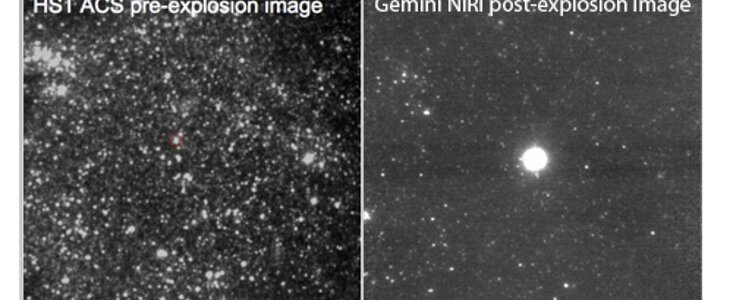A Yellow Supergiant Progenitor of a Massive Star Supernova in M51
8 Agosto 2011
Another supernova has exploded in the Whirlpool Galaxy (M51), and now astronomers have identified its unusual progenitor using data from Gemini.
Several amateur astronomers independently discovered the bright supernova, designated SN 2011dh, early in June 2011. The object was quickly classified as a Type IIb supernova based on its spectrum; this class of supernovae likely arises from massive stars that have lost some, but not all, of their outermost layers of hydrogen.
Within hours of the discovery of SN 2011dh a multi-national science team, including Morgan Fraser (Queens University Belfast, UK) triggered their Gemini Target of Opportunity (ToO) program to obtain high-resolution images with the near-infrared camera NIRI at the Gemini North telescope in Hawai‘i. However, snow and poor weather on Mauna Kea (where Gemini North is located) kept the telescope closed for a few nights, delaying the observations.
When observations were again possible, NIRI was successfully used with the adaptive optics system Altair to correct for the blurring effect of the Earth's atmosphere (known as 'seeing'), allowing the team to obtain an image with a resolution matching that of the Hubble Space Telescope. This comparable high resolution was always an intentional part of the plan: the program was designed to target supernovae that happened to occur in galaxies that had already been observed with the Advanced Camera for Surveys (ACS) on board the Hubble Space Telescope (HST).
As Fraser describes, “By carefully aligning the image of the supernova, to the pre-explosion HST images, we were able to identify a bright yellow supergiant as coincident with the supernova location in pre-explosion images.” The progenitor candidate has a temperature of about 6000K (which is comparable to that of the Sun), but was 13 times the mass of the Sun at the start of its life, and 100,000 times more luminous when it exploded.
The fact that the progenitor candidate identified is a yellow supergiant poses a challenge for current stellar evolutionary models. Over the last three years, there have been several claimed detections of yellow supergiant progenitors for other supernovae (for SN 2008cn and SN 2009kr). However, in both of these cases, the progenitors were considerably more distant and were detected at two wavelengths, so misidentification is possible. SN 2011dh is considerably closer than either of these supernovae, and the progenitor was detected at multiple wavelengths from the ultra-violet to the near-infrared, so the identification is more secure.
Several theories have been proposed to explain the yellow color of these progenitors, including dust, blended stars due to the poor resolution of some images, or the presence of a binary companion. The team is continuing to observe SN 2011dh, and this ongoing work will shed further light on the properties of the supernova and the variety of ways in which a massive star can end its life.
Prof. Stephen Smartt of Queens University Belfast and a collaborator adds, "This supernova has stimulated great interest and many observers are monitoring it in detail before it disappears behind the Sun in a few weeks time. Already there is debate about whether or not the yellow-supergiant could actually be a companion to the supernova progenitor. That's plausible, but the resolution of the debate will need much more data analysis and perhaps waiting to see if the star has disappeared."
Enlaces
- The current work will appear in The Astrophysical Journal Letters, in a paper led by Justyn Maund (Dark Cosmology Centre of the Niels Bohr Institute, University of Copenhagen, Denmark). A preprint is now available.


